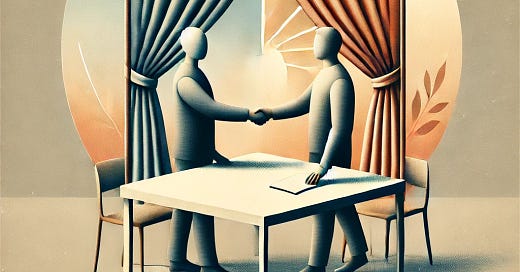My most recent parable, Just Us Folks, was shaped by a simple but radical idea: fairness is freedom. And that idea, for me, comes straight from John Rawls.
Rawls was a political philosopher who asked a question that stuck with me: if you didn’t know where you’d end up in society—rich or poor, healthy or sick, strong or weak—what rules would you agree to live under? He called this starting point the “original position.” Imagine sitting around with your neighbors, designing the blueprint for a new society, but before you can step outside and start building it, someone shakes a hat and tells you to draw a random ticket. That ticket could make you a wealthy merchant or a struggling farmhand. You wouldn’t know ahead of time. So you’d probably play it safe and make sure the society you just built was fair no matter who you turned out to be.
That’s the moral core of Rawls’s work. From this idea, he argued that a just society would prioritize two things: equal basic freedoms for everyone, and fairness in how wealth and opportunities are distributed. You’d allow people to get ahead—but only if doing so made the worst-off better, too. And you’d make sure everyone, regardless of where they were born or who their parents were, had a real chance to rise.
I wanted the valley to feel like that—like a group of people making rules from behind that “veil of ignorance,” as Rawls called it. The characters don’t know who’ll prosper or who’ll struggle, so they build a system that protects everyone.
But here’s the catch: Rawls’s vision has always been more of a guiding star than a map, especially here in the United States. When he first published A Theory of Justice in 1971, America was a very different place. It was the tail end of the post-war boom, a time when the middle class was strong, unions had real power, and the wealth gap—while still present—was far narrower than today. Public investment in schools, infrastructure, and social programs reflected some of Rawls’s principles, even if imperfectly. Yet, even then, America was grappling with the fallout of racial injustice, inequality for women, and the early stirrings of the backlash to government-led efforts to level the playing field.
Fast forward to 2025, and the gap between rich and poor is wider than it’s been in nearly a century. Many people still talk about freedom, but it’s often a hollow kind of freedom. The freedom to starve, to go bankrupt over a hospital bill, or to watch opportunity slip through your fingers because of who your parents were. The political and economic systems we live under have drifted far from the fairness Rawls described. If anything, we’ve moved in the opposite direction: concentrated wealth, eroded safety nets, and a bitter culture war that distracts from the structural inequality beneath it all.
The reality we live in looks more like the later stages of the valley in the story—power concentrated at the top, neighbors divided against each other, and wealth pooled in fewer and fewer hands. Fairness, as Rawls defined it, has been steadily eroded by decades of policy choices that favor hoarding over sharing, and private gain over common good.
But Rawls also gave us a way back. His work reminds us that a society can be rebuilt—not by tearing down individual success, but by ensuring that success lifts others up, too. That’s the heart of the parable. The town flourishes when people remember they’re in it together. When fairness and freedom aren’t treated as opposites but as partners.
This story isn’t just a fable about the past. It’s a reminder for right now.





Absolutely, well put!